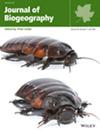Sugar-Rich Resources Mediate Geographic Morphological Variation in a Dominant, Neotropical Savanna Ant
Abstract
Aim
Trait variation across geographic gradients can reveal how species respond to different environmental settings, which is crucial under the growing threat of climate change. Although on the basis of evolutionary theory, the patterns and drivers of intraspecific functional variation remain largely underexplored. In ants, pilosity and body size are morphological traits associated to thermoregulation and heat tolerance, which are critical concerns in the context of global warming. Here, we focused on the dominant ant Camponotus crassus to investigate trait variation and its potential drivers across a latitudinal gradient in the Brazilian Cerrado savanna.
Location
Brazilian Cerrado savanna.
Taxon
Camponotus crassus Mayr, 1862 (Hymenoptera: Formicidae).
Methods
We measured mesosoma pilosity and body size of C. crassus across multiple sites, and evaluated their relationship with temperature, rainfall, solar radiation, vegetation and sugar-rich resource variables. We also assessed morphological and genetic covariation to search for possible phenotypic plasticity or adaptation in C. crassus.
Results
Only sugar-rich resources were found to significantly influence C. crassus pilosity. Specifically, a negative relationship between ant pilosity and sugar-rich resources (i.e., proportion of plants with extrafloral nectaries and hemipteran trophobionts) was found. No covariation between pilosity and genetic dissimilarities was observed, suggesting phenotypic plasticity. None of the variables were significant to predict body size, while this trait positively covaried with genetics.
Main Conclusions
Our findings suggest resource availability as a critical factor for species thermoregulation under environmental change, a hypothesis previously reported in the literature. We emphasise the importance of examining intraspecific variation and phenotypic plasticity across large geographic scales, particularly under the scenario of rapid global change and the current threat to Cerrado savanna. Our work covers a still poorly investigated aspect of intraspecific variation of tropical eusocial insects, and sheds new light on trait variation associated with large geographical gradients and resource availability in a major ecosystem.


 求助内容:
求助内容: 应助结果提醒方式:
应助结果提醒方式:


